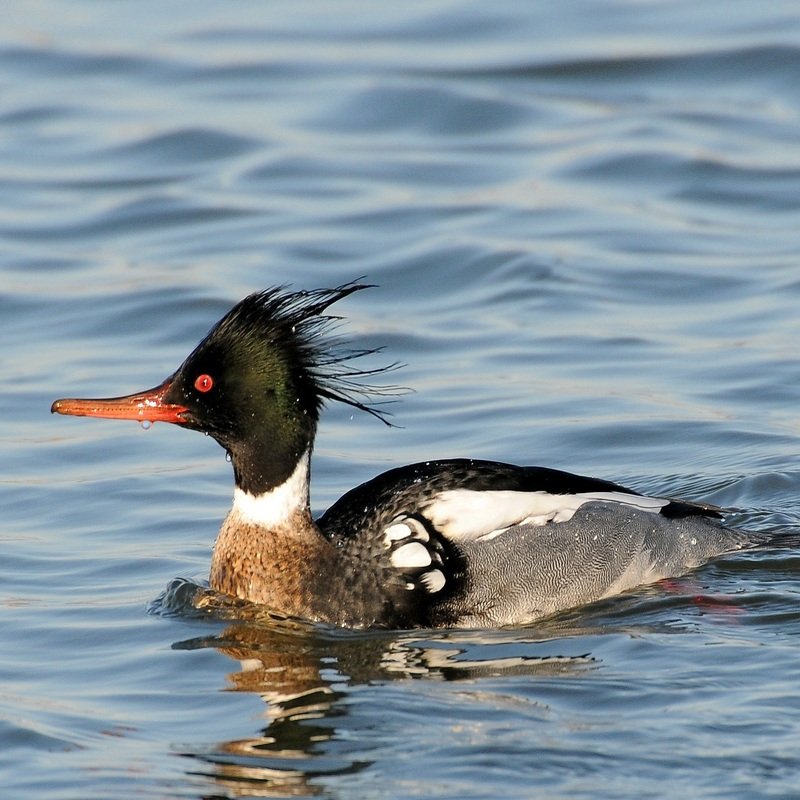Mergus serrator, the red-breasted merganser, is a diving duck and a member of the sawbill family. The genus name is derived from a Latin term used by Pliny and other Roman authors to refer to an unknown waterbird, and serrator is derived from the Latin word serra, “saw.”
Quick Overview: Mergus Serrator – Red-Breasted Merganser
Body size: Around 16-26 in (41-66 cm) and a weight of 1349 g (47.61 oz)
Main colors: Black, Gray, Rust-Brown, White, Green, Orange, Brown-Gray, Red-Brown
Range: Throughout the United States
Migratory Bird: Yes
Best time of the year to see in the U.S.: March, April, May, September, October, November
Conservation Status: Least Concern
Red-Breasted Merganser Description
The black upperparts, gray sides, rust-brown breast, white belly, green head, double crests and neck, and white neck ring distinguish this medium-sized diving duck. Orange is the color of the long, slender beak, legs, and feet. Females are brown-gray in color with a gray-washed, reddish-brown head, double crest, and white breasts and belly.

Size
These birds have a length of 16-26 in (41-66 cm) and a weight of 1349 g (47.61 oz). Their wings could range from 31-35 in (79-89 cm).
Feeding
Red-breasted mergansers feed primarily on tiny fish (ten to fifteen centimeters in length) and crustaceans. Their food is often composed of about 75% small fish, with fewer than 25% crustaceans and other aquatic creatures, such as insects, worms, and amphibians.
Habitat
Red-breasted Mergansers breed in boreal woodland wetlands that are often close to the shore. They breed in fresh, brackish, and saltwater wetlands. They use oceans, lakes, and rivers during migratory and wintering grounds. They prefer saltwater habitats, like estuaries and bays, above freshwater habitats.
Behavior
They are active at all hours of the day. They fly quickly and efficiently and are adept at swimming and diving by propelling themselves forward with their feet. They are unable to walk properly due to their feet being so far back on the body. Mergansers with red breasts spend approximately 50% of their awake hour’s foraging.
Mergus Serrator Scientific Classification
- Kingdom: Animalia
- Phylum: Chordata
- Class: Aves
- Order: Anseriformes
- Family: Anatidae
- Genus: Mergus
- Species: Mergus serrator
Best time of the year to see
In the United States, the best time of year to see these birds are during the Spring season (March-May) and during the Autumn season (September – November).
Distribution of the Red-Breasted Merganser in the USA
Breeds in Alaska, northern Canada, and southern Canada, from Newfoundland to the Great Lakes. Winters primarily along the shores of Alaska, southern Canada, and northern Mexico, as well as the Maritime Provinces, Florida, and the Gulf Coast.
The Red-Breasted Merganser can be found in the following states in the United States – Alabama, Arizona, Arkansas, California, Colorado, Connecticut, Delaware, Georgia, Hawaii, Idaho, Illinois, Indiana, Iowa, Kansas, Kentucky, Louisiana, Maine, Maryland, Massachusetts, Michigan, Minnesota, Mississippi, Missouri, Montana, Nebraska, Nevada, New Hampshire, New Jersey, New Mexico, New York, North Carolina, North Dakota, Ohio, Oklahoma, Oregon, Pennsylvania, Rhode Island, South Carolina, South Dakota, Tennessee, Texas, Utah, Vermont, Virginia, Washington, West Virginia, Wisconsin, and Wyoming.

